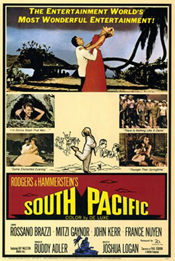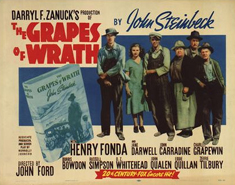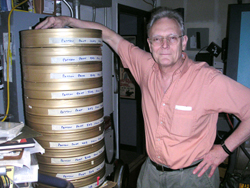Making movies. Enjoying movies. Remembering movies.
THE SCREENING ROOM
Related Articles:
More Articles by Rick
Mitchell
|
By Rick Mitchell

Actually, exhibition seems to have a head start on this, finally getting out of their shoebox multiplex mindset and moving toward large auditoriums with big screens. However, otherwise making the theatrical experience more home like seems counterproductive and while the jury is still out on digital projection, the industry could be exploiting existing technology like 70mm. Not by blowing up 35mm anamorphic or spherical films for sound, as was done in the Eighties, but, for the properly selected films, original 65mm photography that would yield razor sharp images on those large screens with a depth and clarity that will take digital years to achieve, if then. But to be really effective, the films have to be shot so that they will look great on such large screens.
In a recent L.A. Times Sunday Calendar article on the decline in attendance, Peter Bogdanovich mentioned encountering a young film student who was not impressed by John Ford's "The Grapes Of Wrath" (1940) until he had had a chance to see it on the big screen, for which Ford and cinematographer Gregg Toland had designed it. While we boomers who grew up during the 1955-70 roadshow era were consciously impressed by the spectacular nature of films like "How The West Was Won" (1962) and "Lawrence Of Arabia" (1962) subconsciously we were also impressed by the depth and clarity of the images from large negatives viewed on large screens, which is why younger people find such films so underwhelming, especially viewed by "letterboxed" video on a laptop.
Through the Seventies, most artists making regular 35mm films for theatrical release envisioned their works as ultimately being seen on the screens of legendary palaces like the Radio City Music Hall and the Chinese and had them staged and composed accordingly. As a result, even Monogram and PRC "Bs" from the Forties look better on the giant screen of the Egyptian when revived there than many contemporary "A" features. (For the record, in the Forties the Chinese did run double bills with the second feature often a Republic, Monogram, or PRC "B.")
Unfortunately, over the last quarter century the production end of the business has developed a "small screen" mindset, what with the increased use of video assists in production as well as post going almost entirely to video-based editing systems. Where in the past directors, cinematographers, and producers of even "C" pictures saw dailies, as well as progressive cuts, in screening rooms, today, even on expensive "A" productions shot on film, the directors and cinematographers often see dailies only on video monitors and donıt see anything projected onto a screen until they see the answer print!
 |
Tragically there really are no contemporary films suitable for testing
pro-large dramatic screen filmmaking (as Vilmos Zsigmond, ASC once
commented, trying to do such a film in IMAX is a joke), but we who live
in Hollywood regularly get a chance to get some idea of what such
presentations are like thanks to the Dome's annual Cinerama
presentations and the frequent revival of 65/70mm films from the past by
the American Cinematheque, the Los Angeles Museum of Art, and the
Academy of Motion Picture Arts and Sciences, which ran a new 70mm print
of
"Cleopatra" (1963) on May 15.
The American Cinematheque's most recent 70mm Festival offered an
interesting opportunity to contrast different approaches to filmmaking
for large wide screens with rare screenings of 70mm prints of the second
and third Todd-AO productions, "Around The World In Eighty Days" (1956)
and "South Pacific" (1958).
Like "Oklahoma!" (1955), "South Pacific" was produced by a
conglomeration of Rodgers and Hammerstein, the Todd-AO Corporation, and
a specially formed roadshow distribution company called Magna Theaters,
using the production facilities of 20th Century-Fox, which would later
absorb Magna and take over its contract with Todd-AO. Though he'd
initiated and arranged financing for the development of Todd-AO, Michael
Todd was not allowed involvement with Magna, and this becomes
immediately obvious when you compare the Magna productions to Todd's
personal "Around The World."
Todd had initially been involved with Cinerama and, among other things,
was unhappy with Fred Waller's inability to eliminate the visible joins
between the panels. He set out to develop a "Cinerama Out Of One Hole,"
which Dr. Brian O'Brian of American Optical determined could be achieved
by using a 65mm format from 1930, essentially the same one used for "The
Bat Whispers" (see
http://.in70mm.com/newsletter/2005/70/walt/siegmund.htm) with
wide angle lenses, the image projected onto a deeply curved screen. The
shortest lens for this system, which had an 128mm field-of-view, had
fish-eye type distortions which also created a faux Cinerama-like 3-D
effect and was originally intended to be the key element in the process,
yet neither the Magna executives nor "Oklahoma!" director Fred Zinnemann
liked the distortions. The lens would only be used for a handful of
shots in "Oklahoma!" and apparently had been abandoned by the time of
"South Pacific." (The process' filming speed was also reduced from 30
fps to 24 fps to eliminate the necessity of shooting an additional
version for 35mm general release.) As a result, most of "Oklahoma!" and
all of "South Pacific" are shot primarily like 35mm CinemaScope pictures
of the time, though with more full and medium shots than would be used
today.
While the new print of "South Pacific" is gorgeous for the most part,
suggesting that either the negative is in great shape or photochemical
restoration has reached new highs, all in all another accolade for
Schawn Belston of Fox, I personally have to admit that I can't
understand the popularity of this film at the time of its release. It's
a rather strange subject for a musical, episodic with little setup, and
its tone is all over the place. (This may be due to the fact that this
was the 150 minute general release version; a faded 70mm print of the
original roadshow version was shown following the restored print but I
couldnıt stay for it.) The sound, converted to DTS' 6 track digital
format, was terrific, beautifully capturing every note of Alfred
Newman's adaptation and conducting of the score. It was so good that the
singing voice doubles for Rossano Brazzi and John Kerr were all too
obvious. "South Pacific" appears to be the first Fifties 65mm film to
make extensive use of matte paintings, by Emil Kosa, Jr., and
miniatures, some incorporated via split screens, most of which hold up
surprisingly well. (L.B. Abbott, ASC supervised the effects work.) As
for the infamous color filters, well, Leon Shamroy, ASC does make up for
them in his exquisite close-ups of then 17 year old France Nuyen, who
introduced the Egyptian screening. (Again, for the record, all three
original Todd-AO features had their reserved-seat Los Angeles
engagements at the Egyptian. The "80 Days" Egyptian run was its '68
re-issue; the original run played the Carthay Circle.)
 |
|
France Nuyen from "South Pacific" |
"South Pacific" looked great, but was still not as impressive on the
giant Egyptian screen as the fading 1968 print of "Around The World"
shown the previous night. Controlled by Todd, the film was clearly
designed to really exploit the 65/70mm format in a way that only a
handful of later films like "Lawrence Of Arabia," the race scenes in
"Grand Prix" (1966) and Robert Wise's three in the format would.
"Around The World" is clearly influenced by "This Is Cinerama" (1952)
and possibly "Cinerama Holiday" (1955), not only in its scenic POV
shots, but in the dramatic scenes as held. Though Todd supposedly was
not to happy with some of the more "folksy" stuff Merian C. Cooper and
Lowell Thomas added to the second half of "This Is Cinerama," Todd did
respond to its effect on audiences and took the proper lighthearted
approach to the "book" portions of his film, with a lot of help from
humorist S.J. Perelman, who was responsible for much of its "veddy
British" satire. Overall the film is actually very intelligently written
and played with the right touch so that it doesnıt come off as campy. As
for the cameos, aside from the Jose Greco dance troupe number, only the
Marlene Dietrich/ George Raft/ Frank Sinatra bits in the San Francisco
sequence seem to have been specifically concocted for them; the other
cameos come naturally out of the plot and therefore do not annoy
contemporary audiences who may not be familiar with the particular
actors.
I suppose Todd can be credited overall for the film's visual look and
editing, with most scenes played in medium or wider shots, most of which
are photographed with shorter focal length lenses which allow you to see
a tremendous amount of detail in the sets and locations, enhancing the
feeling of being in the picture far more than is possible with long
lenses. In fact, the few tight close-ups, such as in the Hong Kong
sequence where Robert Newton has Cantinflas' drink spiked, and the first
appearance of the steward played by Peter Lorre really stand out thanks
to their contrast to the wider views in the rest of the film. This is
something that really works best in big screen presentations and can
also be experienced with 35mm anamorphic productions from the Fifties
and Sixties that emphasized the use of shorter lenses, but large
negative origination adds a visual dynamic range that 35mm cannot match
(and forget Super 35).
Unfortunately, too many of today's filmmakers are more concerned with
the video than the theatrical release. Granted, the former yields the
greater financial return, but the success in that market is founded on
the filmıs success in the latter. Since older films have proven to be as
successful in home video as more recent video friendly projects, there
is no reason to assume that tailoring a film for theatrical presentation
will hurt its chances in video if it's really successful in theaters.
 |
|
Head Projectionist at the Egyptian, Paul Rayton |
However a new film taking this approach will probably have to come from
a source outside the mainstream industry, as Cinerama and Todd-AO did,
but with the right subject matter, it could be a sleeper and actually
doesnıt need to cost $100,000,000+. But its subject matter needs to be
something that stimulates a desire in at least the contemporary 15-30
year old demographic to want to see it in a theater, not a repeat of the
mistake that doomed the attempted 65mm revival of the Nineties with "Far
And Away" (1992) and "Hamlet" (1996).
These films were influenced by the publicity for Robert A. Harris'
restoration of "Lawrence Of Arabia," considered the ultimate "cerebral
epic." What was ignored was that in the intervening years, such material
had increasingly become associated with TV fare like "Masterpiece
Theater" and those Robert Halmi Hallmark specials. To reacquaint
contemporary audiences with the higher image quality of 65mm, it needed
to be used on films like "Speed" (1994), "Independence Day" (1996),
"Twister" (1996), or "Titanic" (1997). Though a surfeit of badly done
films of this type has reduced their audience appeal in recent years, a
reasonably fresh project done with respect to the audience, designed for
the BIG screen, and shot in 65mm, does have a great chance for success.
Rick Mitchell is a film editor, film director, and film historian. He lives in Los Angeles.
İ 2006 Rick Mitchell. All rights reserved.
IMAGES: İ 20th Century Fox; Michael Coate. All rights reserved.
